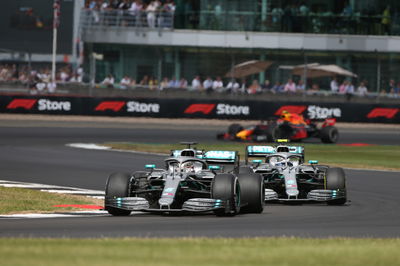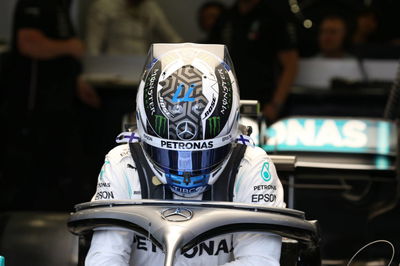Bahrain 2014 influenced Mercedes’ British GP strategic variance
Mercedes believed its split strategy at the British Grand Prix was creating an opportunity for both of its Formula 1 drivers to fight for victory for the entirety of the race.
Hamilton used a one-stop strategy to beat teammate and polesitter Valtteri Bottas - who was two-stopping - to a record sixth British GP win at Silverstone.

Mercedes believed its split strategy at the British Grand Prix was creating an opportunity for both of its Formula 1 drivers to fight for victory for the entirety of the race.
Hamilton used a one-stop strategy to beat teammate and polesitter Valtteri Bottas - who was two-stopping - to a record sixth British GP win at Silverstone.
After the race, Bottas felt Mercedes had made an error by not carrying out a one-stop race, while Mercedes boss Toto Wolff admitted the team would re-evaluate its strategy in future to ensure it is not “unconsciously” favouring one driver over the other.
Speaking in the team’s post-race PurePitwall debrief video, chief strategist James Vowles referred to Hamilton and Nico Rosberg’s titanic battle for victory while on different strategies during the 2014 Bahrain Grand Prix as being a factor behind the team’s thinking.
“We highlighted in the morning, that with one of our two cars we would take the Hard tyre,” said Vowles.
“A couple of reasons, firstly it does create an opportunity for a one-stop race should other circumstances come up.
“Second of all, a little bit like Bahrain 2014, you create an opportunity for both of our cars to race each other throughout the race.
“So, Lewis would have come out behind Valtteri - without the Safety Car - on the Hard tyre, and I think it would have been an incredibly exciting race from then onwards to see who would have had the chance to win.
“With Valtteri, the decision was to go with the fastest race that we believed was possible at the time, which was a two-stop Medium-Medium-Soft, very similar to our competitors and that’s why we fitted the Medium because it was the fastest race overall.”
Vowles also explained Mercedes’ decision not to stop Bottas behind the Safety Car was influenced by the Finn being behind Ferrari’s Sebastian Vettel following his first stop.
“We didn’t stop Valtteri behind the Safety Car because he was behind Vettel on track,” he said.
“Both cars would have come in, both cars would have fitted Hards and really that would have cemented Valtteri’s position until the end of the race in all reality.
“We felt that given the Mediums were only four laps old and given that the car was performing really well, that two-stop strategy for him gave him the best chance overall to get back into that P2 position.”












